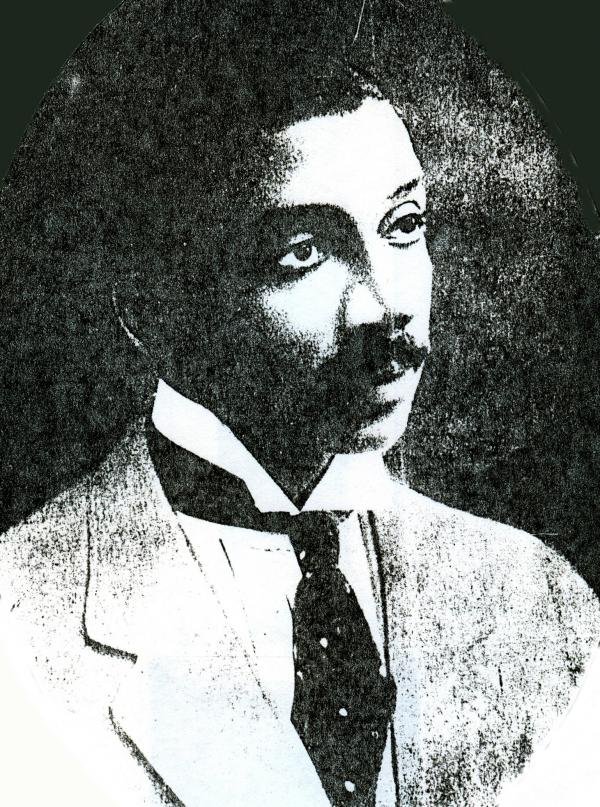How did a late 19th century, three story masterpiece transform into a little blue sign? A valuable piece of black history reduce to a few sentences? Let me tell you:
Walking into the grand New Standard Theatre on South Street, you’d first be struck by high vaulted ceilings, draped in overlapping velvet of various colors. Hundreds of people flow past you to the large, open floor plan and two tiered balcony seating. The theater was the “largest and handsomest” owned by a black man in the country. That man was John T. Gibson—and this was only his first venue.
New Standard Theatre. [Engravings]. Retrieved from https://libwww.freelibrary.org/digital/item/39008

An actor in his early life, Gibson bought the theater in 1914, right at the start of the Great Migration. As black southerners poured into the city of Philadelphia, the theater provided the new arrivals with quality entertainment and a sense of community, and they in turn made John T. Gibson extremely rich. In fact, Gibson would eventually become the richest black man in Philadelphia. He had a house in the suburbs, a home in West Philadelphia, and apparently employed a white chauffeur to drive him around the city in a fancy red car.
John T. Gibson. Credit: Courtesy of the Theater Collection, Free Library of Philadelphia.

On January 19, 1918, Gibson hosted a four year anniversary celebration at the Standard.
In that time, he had hosted 1248 acts and employed 5444 professional dancers, singers, comedians, magicians, and other entertainers on the “chitlin circuit.” The Standard joined a collection of performance venues for entertainers and audiences of color since they were almost uniformly unwelcome at white owned and frequented clubs. This article in the Philadelphia Tribune describes Gibson as a “race man” who believed in “circulating his money among his own people.” Not only did Gibson host Duke Ellington and Louis Armstrong, but he also employed local acts like Ethel Waters, the Nicholas Brothers and others, giving them their start in the business. Denied the opportunity to play in Center City clubs in the early 20th century, black entertainers found a home at the Standard.
Gibson suffered major economic losses during the Great Depression, and the theater finally closed in 1954. The city tore this gorgeous structure and important piece of black musical history down in 1957, and a lone historical marker stands out front of a Jamaican restaurant. I normally focus on jazz, but the loss of this masterpiece makes me wonder what other black owned venues existed during the era of minstrels and vaudeville?
While I do some research, here's a video of the charming Ethel Waters years after her debut at the Standard, singing in Cabin in the Sky, an Oscar nominated musical featuring an all black cast.
100% of the SBD rewards from this #philly5151 post will support the Philadelphia History initiative @phillyhistory. This crypto-experiment is part of a graduate course at Temple University's Center for Public History and is exploring history and empowering education to endow meaning. To learn more click here.
Congratulations @chelseareed! You have completed some achievement on Steemit and have been rewarded with new badge(s) :
Click on any badge to view your own Board of Honor on SteemitBoard.
For more information about SteemitBoard, click here
If you no longer want to receive notifications, reply to this comment with the word
STOPDownvoting a post can decrease pending rewards and make it less visible. Common reasons:
Submit
Great post! I wonder how many long destroyed structures don't even have markers.
Downvoting a post can decrease pending rewards and make it less visible. Common reasons:
Submit
Mmmhm. Also, how can we do something more visual/impactful than markers? Exhibit panels with actual pictures of the buildings (kind of like they have at some Philly bus stops) come to mind as a possibility.
Downvoting a post can decrease pending rewards and make it less visible. Common reasons:
Submit
Great post! And an important question to ask -- will you be looking into other potentially-forgotten black-owned venues in Philadelphia?
Downvoting a post can decrease pending rewards and make it less visible. Common reasons:
Submit
I plan to yes! My #explore1918 posts will likely all be about the unmapped and unmarked musical history in Philly. Check out this one about the Dunbar on Broad and Locust: https://steemit.com/explore1918/@chelseareed/no-place-for-our-people-to-go-the-dunbar-gibson-lincoln-theatre
Downvoting a post can decrease pending rewards and make it less visible. Common reasons:
Submit
I saw that! This is a great and important idea. :)
Downvoting a post can decrease pending rewards and make it less visible. Common reasons:
Submit
I love that Jamaican restaurant (seriously, that plantain stew...)! And I never realized that this building had been right there. Clearly it needs more than just a little blue plque
Downvoting a post can decrease pending rewards and make it less visible. Common reasons:
Submit
They're just so easy to ignore, and you can't tell an engaging story with two sentences. Or point people towards more info. We need a better dang system.
Downvoting a post can decrease pending rewards and make it less visible. Common reasons:
Submit